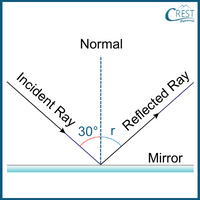1. Janet conducted an experiment to study the reflection of light using a mirror. What effect would occur if the surface of the mirror is rough instead of smooth?
a) The reflection would become brighter.
b) The reflection would become dimmer.
c) The reflection would become distorted.
d) The reflection would remain the same.
Answer: c) When the surface of the mirror is rough, the irregularities on the surface cause the light rays to reflect in various directions. This scattering of light leads to a distorted reflection, where the image appears blurred or uneven.
2. A beam of light hits a mirror at an angle shown in the diagram. What would be the angle of reflection?

a) 15 degrees
b) 30 degrees
c) 60 degrees
d) It cannot be determined
Answer: b) According to the laws of reflection, when a beam of light hits a mirror, the angle of incidence (the angle at which the light hits the mirror) is equal to the angle of reflection (the angle at which the light reflects off the mirror). In this case, the beam of light hits the mirror at an angle of 30 degrees, so the angle of reflection will also be 30 degrees.
3. What happens to the size of an image formed by a plane mirror compared to the size of the object?
a) The image is larger than the object
b) The image is smaller than the object
c) The image is the same size as the object
d) The size of the image depends on the distance from the mirror
Answer: c) When an object is reflected in a plane mirror, the image formed appears to be the same size as the object itself. Plane mirrors produce a reflection where the dimensions of the image are identical to the dimensions of the object.
4. Consider the following statements about image and shadow and choose the correct option:
Statement I: An image is always smaller than the object, while a shadow is always larger than the object.
Statement II: An image is formed when light is blocked by an object, while a shadow is formed when light is reflected by an object.
a) Statement I is correct but statement II is incorrect.
b) Statement I is incorrect but statement II is correct.
c) Both statements are correct.
d) Both statements are incorrect.
Answer: d) Statement I is incorrect because an image can be smaller, larger, or the same size as the object, depending on the type of mirror or lens used.
Statement II is incorrect because an image is formed through the reflection or refraction of light, not by blocking light. A shadow, on the other hand, is formed when light is blocked by an object, resulting in an area of darkness behind the object. Therefore, both statements are incorrect.
5. Which of the following is an example of a virtual image?
a) A photograph captured by a camera
b) Your reflection in a mirror
c) The shadow of an object on the ground
d) A rainbow formed by sunlight
Answer: d) A virtual image is an image that appears to be behind a mirror or lens and cannot be projected onto a screen or surface. Your reflection in a mirror is an example of a virtual image because it is formed through the reflection of light rays from the mirror.


